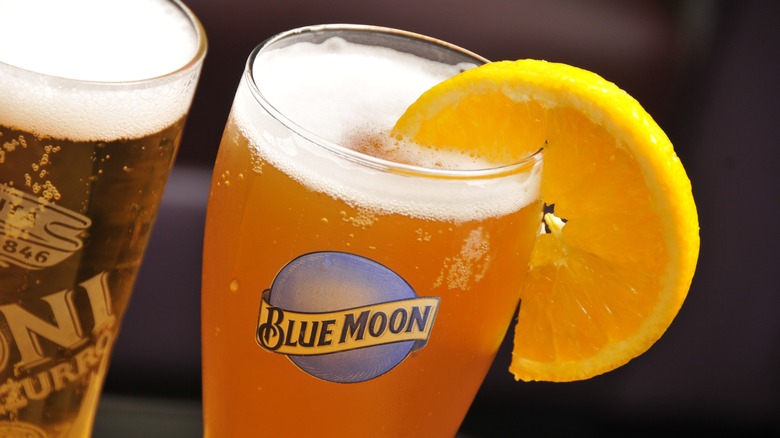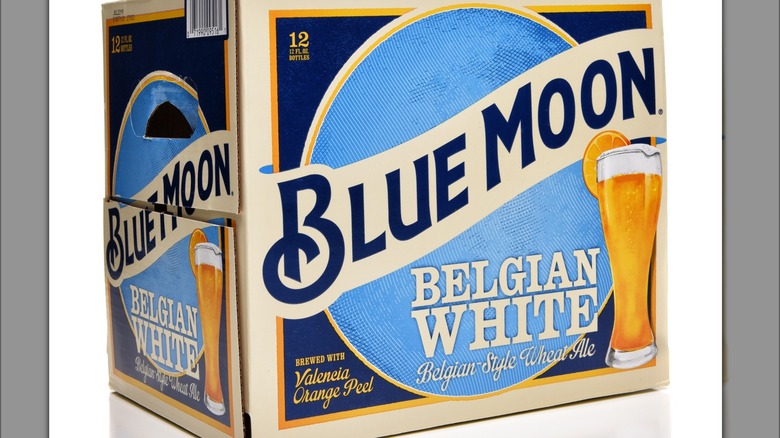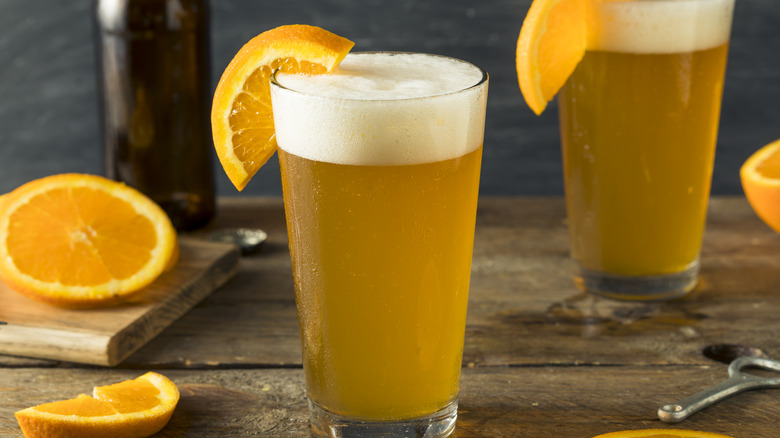Why You'll Always Get An Orange Garnish When You Order A Blue Moon
With the craft beer revolution that's filled supermarket aisles with colorful and fruit-forward brews, an orange wheel garnish on a foaming glass of beer isn't a rare sight anymore. At one point, however, using an orange to garnish beer was a completely novel concept and one that was seemingly introduced to America one bar at a time. The beer getting the orange garnish was Blue Moon Belgian White, and the person popularizing the idea was its inventor, Keith Villa.
Citrus in beer isn't a new concept and just like Corona popularized the idea of a lemon wedge in summer lagers, Blue Moon has done that for the orange garnish. The journey hasn't been easy, and the beer brand has done a lot (creatively) to make its Belgian-style wheat ale synonymous with an orange garnish — from changing the beer label to include an orange to advertisements featuring oranges raining down from the sky. A joint campaign with the Florida Department of Citrus called "artfully garnished" also offered Blue Moon beer buyers discounts on bags of oranges.
While it's certainly raised the beer's visibility, the orange garnish is actually a crucial part of enjoying Blue Moon's own orange citrus notes. Despite being a Belgian-inspired brew, this beer is specifically curated for the North American palette and Keith Villa's obsession with the orange in his beer is to ensure that those pleasing notes get noticed by drinkers as soon as they take the first sip.
The Blue Moon orange garnish started one bar at a time
Before Blue Moon (originally named Bellyslide Wit) was created in 1995, the American beer market predominantly consisted of relatively humdrum lagers. This was before Anheuser-Busch's vast portfolio of local beers was a thing, and most people were used to the staple Miller and Coors brews.
The man behind Blue Moon, Keith Villa, was a student of molecular biology headed to medical school before a research position at Coors Brewing Company caught his attention. The company sent him to Belgium to study brewing and Villa returned with a Ph.D. in science and an appreciation for Belgian ales and witbiers. Realizing that the American palette would prefer slightly sweeter notes, Villa decided to substitute the traditional tart Curaçao orange peel with sweeter Valencia orange peel in the Belgian-style beer he formulated for Coors.
While most bartenders initially served Blue Moon with a lemon wedge (which is how they served Belgian wheat beers), an orange slice was required to bolster the sweet Valencia orange notes in the beer. Villa took it upon himself to go from bar to bar in his hometown, Denver, suggesting the new garnish. He even brought oranges along. Initially drawn to the novel visual of the garnish and then impressed by the flavor (Villa was focused on "first-sip likeability"), bar patrons caught on to an orange wheel in their beer. Sales of the beer soared and the Blue Moon and orange combo has been around ever since.
Orange and beer is a tasty combination when done right
While no single beer has arguably done as much as Blue Moon to popularize an orange garnish on beer, some other brews also benefit from it. The traditional recipe for Belgian witbier includes orange peel, so an orange garnish on beers like Hoegaarden is common. Beer purists may understandably oppose the addition of fruit to their brews. However, orange notes from a garnish can bring out the sweet and bitter flavors of the beverage. To go even heavier on fruity notes, try making a beermosa or a beer spritz.
Of course, you can't go around dunking oranges into every pint and there are more effective ways to make beer taste better. The garnish should complement the beer's characteristics and bolster certain notes of the brew rather than contrasting them so the beer's original taste and aroma are preserved.
Consequently, citrus additions should generally be made to beers with citrus notes. Apart from Belgian wheat beers, summer lagers and some IPAs also have citrus notes and benefit from lemon, orange, or even grapefruit wedges. Sour beers, on the other hand, have enough complex sour notes and do not benefit from a citrus garnish; neither do stouts and dark ales. Despite all the taste science at work, personal preference dictates the choice of garnish, but this is a classic pairing, wherever you're sourcing the sun-soaked beauties.


